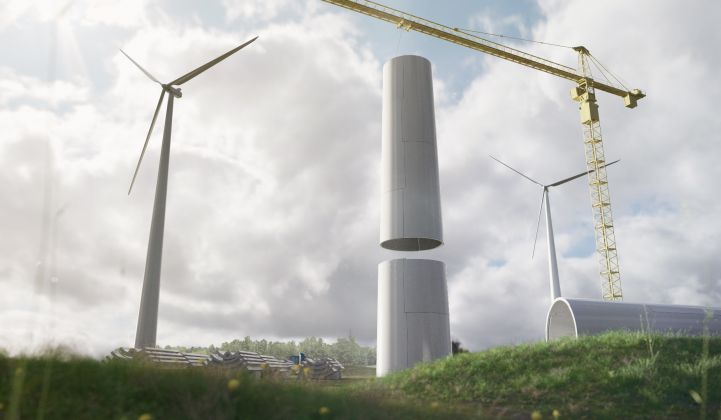Wind turbine market leader Vestas has revealed the first investment made by its venture fund with a stake in Swedish wooden wind tower start-up Modvion.
Modvion builds wind towers from sections of specially prepared wood laminate panels. As well as being lighter, the modular nature means transporting the towers to the construction sites is far easier.
As onshore wind turbines increase in size beyond the 6-megawatt mark, hub heights and towers will need to grow too. If successfully commercialized, Modvion’s solution would solve the transport problem, while also replacing carbon intensive-steel with what could be a carbon-negative alternative.
No details on the size of the deal have been released but Vestas previously told Greentech Media that Vestas Ventures would look to invest €1 million to €6 million ($1.2 million to $7.2 million) at a time.
Vestas Ventures launched in November with a view to taking small stakes in start-ups to seed innovation and gain better insight on emerging technologies.
It focuses on four key areas: long-duration storage and other grid flexibility tech; "power-to-X" technologies to use renewable electricity to produce carbon-neutral fuels; wind energy technologies; and sustainability and advanced materials.
Bo Svoldgaard, senior VP and head of innovation, said this first investment is an excellent fit for Vestas.
“We believe this will be a commercial business in the future and it also ticks the sustainability box. This is not only about producing green electricity, it's about doing so in a sustainable way,” he said in an interview.
To make taller steel towers, either the thickness of the walls has to increase or the diameter of the tower must grow. That diameter is limited in most markets by the maximum width of a load permitted to travel on public roads. The length of tower sections can also be a limiting factor on turns.
“We believe that this design will fit future turbine sizes and ratings when we are at the 5 megawatts, 6 megawatts and beyond for onshore and tower heights of 140, 150 meters,” said Svoldgaard.
Modvion also claims that the towers would only require a few alterations to serve the growing offshore market. Svoldgaard said the investment has been made with the onshore market in mind so any developments in the offshore market would be a bonus.
 Modvion's production facility in Sweden. (Credit: Modvion)
Modvion's production facility in Sweden. (Credit: Modvion)
First commercial Modvion wind tower next year
A 38-meter prototype has been installed already. Certification for commercial-scale towers is underway.
“Modvion’s first commercial-scale turbine tower will be installed in 2022,” Otto Lundman, Modvion’s CEO told GTM in an email. “Modvion is currently further automating our production technology before taking the production line for the first commercial-scale tower into operations in our R&D facility in Gothenburg,” he added.
“The first volume production unit is planned to go into operations in 2023 and we of course aim to accelerate our production scale-up in order to be ready to supply a larger market,” wrote Lundman.
Svoldgaard said there was scope for production in Europe, U.S. and Asia given that the material itself builds on the established laminated wood veneers used widely in the construction industry.
As developers are increasingly looking for options to add local content to their projects, Lundman agreed that manufacturing could be replicated.
“Sustainably sourced wood can be found in many places around the world and good manufacturing partners as well. So we look forward to supplying increasing markets also with local manufacturing,” Lundman wrote.
There is also potential that wooden towers could prove to be more fire-resistant than steel. Lundman noted that testing that replicated wildfire conditions would be required in order to confirm, but the fundamentals remain. Steel becomes soft when heated while large wood structures will char on the outside but retain their strength.
For now, the focus is on the potential for Modvion’s towers to match the trend for bigger turbines and pressure for lower carbon deployment.
“We see more and more requirements on circularity and reuse of materials,” said Svoldgaard. “We know when producing this kind of tower in comparison to steel this will reduce the CO2 footprint by 80 percent.”




